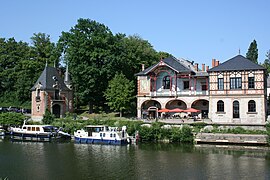Sarreguemines
Sarreguemines (French pronunciation: [saʁɡəmin]; German: Saargemünd [zaːɐ̯ɡəˈmʏnt] , Lorraine Franconian: Saargemìnn) is a commune in the Moselle department of the Grand Est administrative region in north-eastern France.
You can help expand this article with text translated from the corresponding article in French. (December 2008) Click [show] for important translation instructions.
|
It is the seat of an arrondissement and a canton. As of 2020, the town's population was 20,555. The inhabitants of the commune are known as Sarregueminois and Sarregueminoises in French.





